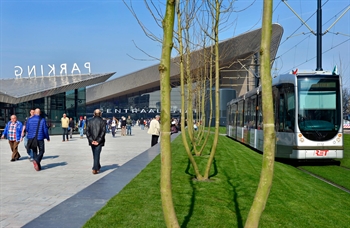Fact sheet Marketplace for Mobility
With its Marketplace for Mobility programme, the public-private partnership De Verkeersonderneming, involving Rijkswaterstaat and the city of Rotterdam among others, calls on private enterprises to present concrete solutions for improving accessibility in the Rotterdam region. De Verkeersonderneming serves as the market superintendent in this process, matching the supply to the demand. There have been two rounds of tenders to date, in 2011 and 2015.
This new approach was a response to trends such as the more facilitative role of government, greater independence and outspokenness of citizens and desire to mobilise the brainpower and daring of the market. An extensive description of this measure can be found in the case study Marketplace for Mobility.
Accessibility effects
The deployment of the mobility services on the Marketplace for Mobility resulted in a total of 2,180 instances of rush-hour avoidance per day. A common trait of successful service providers is that they are established, experienced entrepreneurs familiar with Rotterdam and the surrounding area.
Among other things, they offer services in the field of boosting cycling, public transport, mobility tickets, collective transport, water taxis, journey planners, management of mobility budgets and relocation programmes. These services have led to a drop in car use and to greater use of other modes of mobility, such as cycling and public transport.
Other participating mobility services focused on avoidance of rush-hour traffic and emphasised the benefits of working from home. There has been a mixed effect: various alternatives have been used to achieve avoidance of rush-hour traffic. Not much is known about how this approach translates to the various behavioural alternatives.
Long-term effects
Not much is yet known on the long-term effect of this approach. It is assumed that the approach will lead to structural rush-hour avoidance. The first step is to make people aware of their travel behaviour and the alternatives available, then allow them to become accustomed to avoiding peak traffic using incentives, and ultimately offer them a permanent alternative in the form of a mobility service. Many services have proved successful at this: they still exist and are having an impact.
Sustainability effects
It is difficult to determine the exact effects on sustainability that any rush-hour avoidance achieved may have, since the breakdown per alternative is unknown. The overview provided below is based on the following assumptions:
- Instances of rush-hour avoidance for an average commute distance of 24 km
- Distributed equally across the alternatives:
- working from home (no emissions)
- cycling (no emissions)
- public transport (fewer emissions)
- peak-time avoidance (possible emissions)
Using this information the following emissions will be saved per instance of rush-hour avoidance:
| CO2 | NOx | PM10 |
|---|---|---|
| 2.1 | 0.0026 | 0.00030 |
Variables with an impact on effects
The Marketplace for Mobility works well in Rotterdam because planners have adopted an integrated approach. This includes building awareness through marketing campaigns, rewarding road users for avoiding peak traffic through various projects and then offering them alternative means of travel through the Marketplace for Mobility (see also the Marketplace for Mobility case study). This requires staying power, over at least several years. The following variables influence the overall effects:
- The Marketplace offers both services that are aimed at employers and those that directly target road users. Services aimed at employers often need more time before they lead to changes in the end user's behaviour.
- In addition to co-funding, many service providers (often start-ups) experienced a need for marketing expertise, which was provided by bringing in coaches.
- The mix of services that apply for a particular Marketplace will depend on the particular regional characteristics. A large city with many potential customers, many short car trips and a high-quality public transport network will have more (and a greater variety) of options than a remote industrial zone. In the Rotterdam region, the Marketplace services are primarily being operated for the city centre and the areas adjacent to the ring road; the effects are thus primarily representative of an urban area.
Costs (including VAT)
The cost of the regional approach being taken in preparation for the Marketplace is around €3 million. The costs of the tender procedure for the Marketplace financed by public funds are estimated to be €4.7 million. These costs cover a period of three years. Based on 2,180 instances of rush-hour avoidance per day for three years, the cost per daily instance per year amounts to about €1,200. Based on 200 business days in the year, the cost for each unique instance of rush-hour avoidance comes to around €6.
For more information
See www.verkeersonderneming.nl/mobiliteit
Sources consulted
- De Verkeersonderneming (2015) Evaluatie Marktplaats voor Mobiliteit (Evaluation of Marketplace for Mobility)
- Veen, O. van der (2015) Evaluatie Marktplaats voor Mobiliteit
Rules of thumb
- effect on accessibility: 2,180 instances of rush-hour avoidance per day
- effect on sustainability: reduction of 2.5 kg of CO2 per instance of rush-hour avoidance
- costs: approximately €6 per instance of rush-hour avoidance

